Edgar Degas did himself a tremendous disservice by being as subtle an artist as he was. He also did his admirers a great disservice, for no matter where I mention his name, to whom or in what context, there is always a detractor, always a deluge of impassioned by sadly misdirected feminist critique. Always from the peanut gallery queries as to why you support such blatantly sexist and borderline pedophiliac art. So, in print and in the public forum for you all to chew on, here is my official (partial) defense of Degas, one of my favorite artists.
It makes sense to begin with some background, so let’s do just that. Degas was a contemporary of the Impressionists, though he shirked that label, and with good reason. Though he shared a similar aesthetic sensibility, he was working in a very different vein. We’ve all heard of the Impressionists, and most of us who’ve been to a respectable museum have seen a Monet, but let’s give a little background on these guys.
Impressionism evolved artistically from the Barbizon School and philosophically from both the work of the realists and the post-Marxist, industrial world. The Barbizon School, named after the French town of Barbizon, where the artists would gather to work, was a group of painters who found their inspiration in fresh air. They took to the Fontainebleau Forest to paint directly from nature. This resulted in much more natural-looking work, and marked a distinct shift away from previous, omniscient landscapes. While artist who preceded the Barbizon School polished their works to an unrealistic sheen in studios, the work of the school itself had distinct focal points, as though, when looking at the canvass, we see what a human eye is actually seeing. The strong aesthetic choice of painting directly from nature and the vantage point of the human eye would have a tremendous impact on the Impressionists.
The Realists, also a French school of painting, weren’t realists in style as much as in content. Rather than mining the same vacuous, pastel idiocy of the Rococo artists or the historical grandiosity of the Neoclassicists, the Realists depicted the day-to-day life of the lower echelons of French society. Artists like Courbet and Millet painted scenes of rock breakers (very poor workers whose job it was to actually break big rocks into smaller rocks – a classic painting of Courbet’s that was destroyed by the firebombing of Dresden during WWII), gleaners (also very poor workers, who would glean fields after the harvest), and funerals. Realists monumentalized the working classes and commented on the disparity of modern conditions.
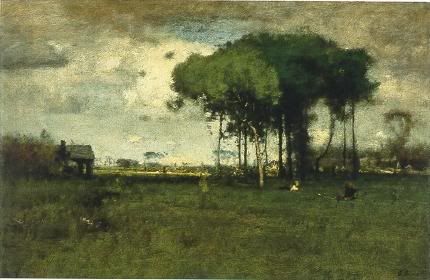
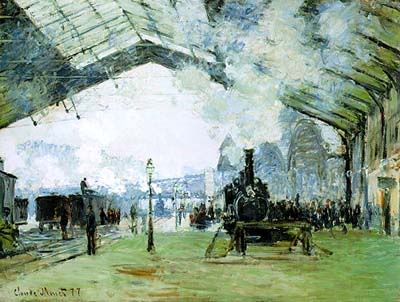
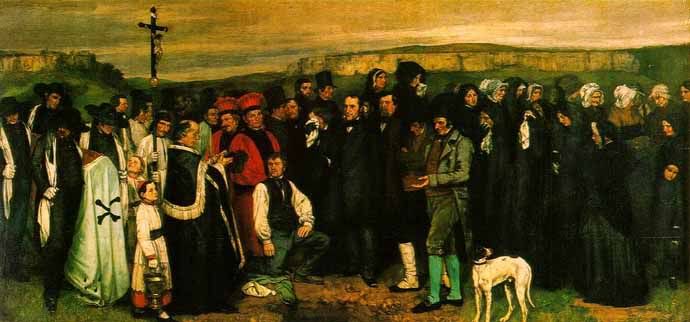
(A) A typical Barbizon painting (B) Monet's view of temporal modernity (C) Courbet's monumental lower-class funeral
Impressionism, then, incorporated these schools and more. The Impressionists were called such because they intended their work to be as the world is seen, rather than, as an omniscient would see the world. The Impressionists were interested not in providing authoritative depictions of any one theme or subject, but rather in giving their own, individual impressions of the way the world was. This approach places great emphasis on subjectivity.
The Impressionist’s saw the modern, post-industrial world of one of great, constant change. They saw the misery of the working classes and the myriad devices in place to maintain that misery. They painted from the perspective of a world composed of endless instances, not a continuous stream of time. Their compositions were influenced by the human eye and the temporal, spontaneous nature of photography.
Degas was an Impressionist in his preoccupation with documenting the instances of the present, though was greatly influenced by the Realists, and their very thorough documentation of the French peoples and their various struggles.
The Dancers
Degas draws a great deal of criticism from both within and beyond the world of art. Mostly, the argument is that well here this guy is painting little girls in ballerina outfits so he’s fetishizing children, women, ballet, and portraying women as weak, interchangeable objects to put on display for the world. For some reason, it doesn’t seem to enter the mind of the criticizer that this may be intended itself as criticism. Let’s look directly at a few works of art and see what we can find.
On first glance, it’s a room full of girls in ballet costumes. There’s an old man with a cane standing by watching as some dance, others practice, and a few get warmed up. The immediate interpretation may err to the pervy: here’s a full grown man painting a bunch of young women in skimpy costumes exposing their lithe bodies being watched by an older man. Closer observation tells a different tale, though.
(A) Dance Class and (B) The Rehearsal, both in the collection of New York's Metropolitan Museum of Art
What we clearly see is a group of women in preparation. They’re getting ready to rehearse, in order to perform. The Impressionists were very much of the belief that Paris of their day was a place of grand performance, one in which simply going out of the house the cities denizens put on a face. What Degas gives us in the dancers is a cynical critique on the rearing of a new generation, all of them posited as performers, prepared to live a life of image and falsity. As further testament to his negative commentary on the conditions of his Paris, we need only look out of the studio’s window. Degas could very well have given us something lovely and pastoral, a scene of rural pageantry to echo the supposed objectification of his girls. Instead, he gives us some smoke stacks and other signs of industrial decay. With this in mind, we understand the Paris beyond the window as one of slums, industry, façade, and decadence. The atmosphere the dancers are in is a false one, a den of preparation behind closed doors. Degas plainly tells us, given contextual clues, that these girls are being groomed for a life of display; they are objectified, but by their society, not the artist.
Degas continues the theme of dancers with a series of paintings of the women during dress rehearsal and performance, on stage. These women are older, and their setting is a more realistic fabrication of actuality. Rather than the bare prep room of childhood, the post-adolescent women are smeared with garish make up and tossed under stage lighting. They pose against sets, watched by suspicious men (directors and choreographers) and full-house audiences. The sets are a false reality; the costumes and make up, a false self. The audience is modern society, glaring in silent judgment. The suspicious men are the forces of manipulation, maneuvering women into “their place”.
In continuing his dancers them, Degas very plainly offers a feminist critique of the machinations of his Paris. Further evidence can be found in a very different series of paintings, in which he created a view of the modern, melancholy woman, alone, forced into competition with fellow women for the objectification and favor of men. The much more apparent criticism of these paintings serve to reiterate our reading of his dancers.
But…
But, well, here’s where the partial comes into the defense. It’s plainly documented that Degas was incredibly conservative and a raging anti-Semite. This isn’t something I intend to defend in anyway. And while it’s easy and art historically valid to read Degas’ work as a critique of the post-industrial world’s treatment of women and objectification of people on grand scale, what kind of alternate readings can we find knowing that the artist was so staunchly conservative?
It’s possible that Degas didn’t at all see Parisian society of his day as bad in that it was dehumanizing or demoralizing but rather in that it was turning France’s regal elegance into mass-produced, smoke-choked garbage. Looking at the first dancer painting in this manner, it’s possible that he sees the girls in their costumes as beautiful and precious, gentle objects forced to exist in harsh conditions. As such, when they grow older, the make up and stage props and costumes are not as much the impositions as an objectifying society as much as they are defense mechanisms the women put on themselves so as to avoid the depressing realities of the day.
So…
Degas is a tricky fellow. He was an artist very much of his time, a great detailer of contemporary life. In fact, he preferred to think of himself as a Realist, rather than an Impressionist. That the Realists were mostly very liberal chroniclers of working class oppression is interesting, given that Degas was as conservative as he was, meaning that probably by contemporary standards he would fall into the bizarre libertarian-esque gray world that is both very liberal (everyone should be free) and very conservative (government should stay the hell out of people’s business). Or it’s possible also that Degas, in being very conservative, was also very liberal. To rephrase: Degas stood opposed to many of societies advancements because they represented changes to traditional modes of life, and yet, in standing opposed to them, he stood opposed to a good deal of industrial society’s oppressive machinations. In being backward, he was progressive. It’s possible that he saw the dancers of Paris, who invested themselves in physically demanding work for the benefit of others, as parallel to the gleaners and stone breakers of more rural settings. But then maybe he just though they were nice to look at and emblematic of the times. Indeed (chin stroking ensues), it’s a very real possibility that the paintings were not fetishized and were not liberal condemnations and were not conservative yearnings for a more simple time but were in fact simply something that he saw, an abstraction of form or representation of life that appealed to his sense of aesthetic and documentation. As you can see, all of this makes his art very trick to read, as much of it can be interpreted either way.
This brings us to a Barthesian place, wherein the author (or, in this case, painter) must be presumed dead (which is easy with Degas because he’s actually dead), and the reader must decide ultimately what the paintings are about. Degas was known to portray deep psychological complexities in his portraits, imbuing the eyes of his subjects with a sense of conflict and loneliness. Perhaps the same is true of Degas; he may have been much like his subjects and in that way much like all of us (as he was, after all, just a guy), a man of conflicting tendencies in a conflicted time who created art out of a spider’s web of intent and belief, rather than a straight, obvious line. Though we’ll never know how we were intended to interpret Degas’ work, hopefully after all this discoursing, one thing’s for sure: he wasn’t painting girls in pretty costumes for purposes of objectification of fetishism.
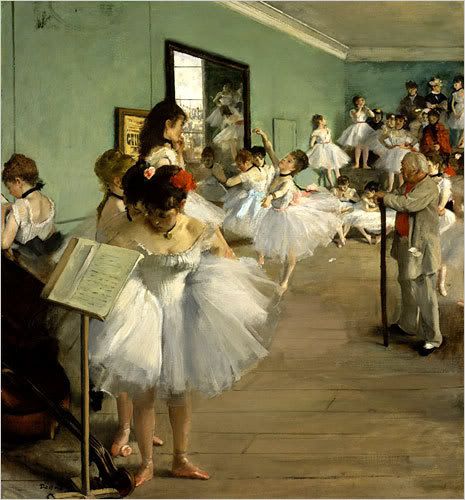
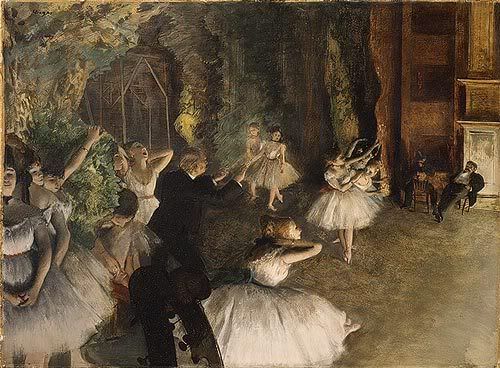


No comments:
Post a Comment